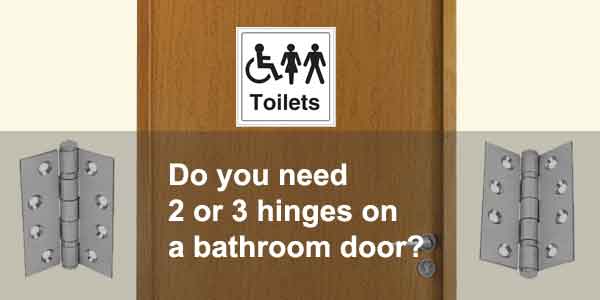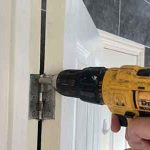In most residential properties, doors are hung with two hinges. However, there are certain circumstances where a third hinge may be recommended. This is often a debated topic, and people don’t always agree when three hinges are required.
But as a general rule, a third hinge will only be used in certain circumstances. These include:
- Where heavier doors are being installed.
- On fire doors
- Where a door may be subject to more movement,.

A bathroom door will often be fitted with a third hinge. The main reason for this, is a bathroom door is subject to more moisture. Therefore, it is more prone to movement. This includes things like warping, twisting, and bowing. A third hinge will often help to reduce this type of movement.
With that said, not every bathroom door will require a third hinge. It will depend on the type of door that is being fitted. Plus, it’s one of those times where different people will have varying opinions.
Below, we will look at examples of when you may, or may not want a third hinge on your bathroom door. As well as some other tips, to ensure you hang your door well and reduce movement.
Types of bathroom door and whether three hinges are required
To start with, it’s important to point out, that there is only one occasion when three hinges on a bathroom door is mandatory. This is when the bathroom door is a fire door. However, this scenario is not that common.
For a bathroom door to require a fire door, it would need to be located between a bedroom and a protected stairway. This would most likely happen with something like an en-suite bathroom.
You can see a good ilustrated example of this regulation from the NHBC here.
In any other case, it is not a regulated requirement. However, it still may be a recommendation.
Hollow core doors
This is a very popular, inexpensive type of door, that is very common in homes throughout the country. These doors can be flush with a simple flat facing, or moulded doors with a paneled design. The latter is the most common and most aesthetically pleasing, due to its more decorative and traditional style.
Regardless of their design, these doors are extremely light. They are constructed with thin solid faces, then inside they have a type of corrugated, or honeycomb cardboard centre.
Due to their appearance inside, these doors are often known as egg box doors.
This type of door will never need a third hinge. The are extremely light and do not suffer from movement as much as solid timber doors.
Low-cost solid softwood doors
These doors are usually quite light. They are generally panel doors, made from soft wood such as pine. Due to being solid timber, the doors can be susceptible to movement. This is usually as a result of excess moisture, but they are still pretty lightweight. For this reason, you wouldn’t usually hang these with three hinges.
However, you may decide to use a third hinge in a bathroom. This would mainly be as a precaution, to reduce the chance of movement in the door.
It is also more common if you are working with particularly heavy softwood doors.
Hardwood doors
The argument for a third hinge on a hardwood bathroom door, is more persuasive. For starters the door is heavier. This means you could potentially be using three hinges on all doors throughout the property.
In this case, the third hinge takes a percentage of the load away from the other hinges.
When it comes to the bathroom, you are installing a third hinge for two reasons. Firstly the door is heavy, and secondly there is excess moisture that could cause more movement in the door.
Also, if all the other doors have three hinges, it would make sense to have three hinges on your bathroom door as well.
The opposite is often the argument against three hinges on other doors. For example, if all the other doors in a house have only two hinges, then three hinges on a bathroom door will look out of place. This is a purely aesthetic argument, but it is a common reason for not adding a third hinge.
Other ways to reduce movement
There are a few other things you can do to reduce the chance of movement in your door. These can be done, regardless of whether you install two, or three hinges.
Stop the door absorbing moisture
The reason doors move, is generally due to moisture. This causes the wood to expand and contract, which can result in other defects such as warping.
The best way to fight against this, is to prevent the moisture getting into the door in the first place.
- Seal areas that were planed during fitting – This is mainly the sides, top, and bottom of the door.
The area that is neglected most often, is the bottom. It is very common for someone to shorten a door and then never seal and paint the bottom. This is the perfect area for moisture to soak into the door. - Well fitted hinges – The hinges are cut into the door and then fitted. You should ensure that the hinges fit tight, this will avoid moisture seeping through gaps around them. Fill in any gaps, and paint right up to the hinge.
The same rule should also be followed for things like face plates and door keeps. Just make sure there are no easy gaps for moisture to get in. - Reduce moisture – The most obvious way to stop your door absorbing moisture, is to reduce moisture. Something simple like adding an extractor fan can have a huge impact on the amount of water vapour that is removed from your bathroom.
Another low cost, easy option is a dehumidifier. You can see an example of a decent dehumidifier by clicking here.
Chop hinges into both the door and the frame
One other thing I really hate to see, is people only chopping the hinges into the door and not the casing. This usually means they will cut the hinge deeper into the door and then just screw it straight to the casing.
Firstly, this is rough! It looks rough and its lazy. I don’t care if it’s the lightest egg box door you could find. You should have some pride in your work and do the job properly.
Not only will it look better, but it will also mean the door is hung in a more solid way. By just screwing the hinge straight to the frame, you are asking for movement.
Cut the depth of the hinge, into both the door and the frame, and you have a perfectly fitted door. It will look neater, and it will also deal with movement far better.
Conclusion
Except for areas where a fire door is a requirement. Three hinges on a bathroom door is not a strict rule. However, there are several occasions when it does make sense.
Hopefully this article has given you a good idea of when three hinges on a bathroom door is a good idea.




